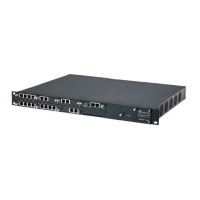Installation & Operation Manual 278 Document # LTRT-92224
Mediant 8000
To configure the basic Media Gateway Controller parameters:
1. Click
to access the Media Gateway status screen.
2. Select the specific Media Gateway board.
3. In the Navigation pane, select Call Control
MGCs; the MGCs list is displayed.
4. Use the
or buttons to add or remove entries.
5. Select a specific row and then in the configuration pane, click Call Control
Settings; the Call Control Settings screen is displayed.
6. Configure the MGC parameters according to the table below.
7. Click the Maintenance icon
and select Unlock to activate the configuration.
31.2 MGCP Control Protocol
The MGCP (Media Gateway Control Protocol) is a standards-based network control
protocol, as defined by IETF RFC 3435 and RFC 3660.
In MGCP architecture, call control intelligence resides outside the Media Gateway and
is handled by the external call control element, the Call Agent (Media Gateway
Controller). The Media Gateway contains endpoints on which the Call Agent can
create, modify and delete connections to establish and control media sessions with
other endpoints. In addition, the Call Agent can instruct the endpoints to detect certain
events and generate signals. The endpoints automatically communicate changes in
service state to the Call Agent. Also, the Call Agent can audit endpoints, as well as the
connection on endpoints.
31.3 MEGACO Control Protocol
The Megaco (MEdia GAteway COntrol) protocol is a standards-based network control
protocol, as defined by IETF RFC 3015 and ITU-T H.248.
Similar to MGCP architecture, in Megaco architecture, call control intelligence resides
outside the Media Gateway and is handled by the external call control element, the
Media Gateway Controller. On the Media Gateway side, the connection is handled
using two elements: Terminations and Contexts.
Termination is the basic element of the call. There is a physical Termination
representing a physical entity (e.g., B-channel), and an ephemeral Termination
representing the generated stream. To create a connection, a Context is used. A
Context contains one or more Terminations and describes the topology between the
Terminations. A typical connection creation command creates a new Context and
adds into it one physical Termination and one new (ephemeral) Termination. The
ephemeral Termination parameters describe the media type and the stream direction
(SendReceive, SendOnly or ReceiveOnly).

